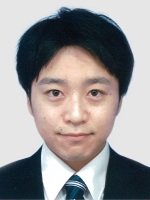 Press Release 2023
Press Release 2023
Precise Chemical Doping of Organic Semiconductors in an Aqueous Solution
—Technique Could Revolutionize the Flexible Device Industry—
University of Tokyo
Tokyo University of Science
A research team consisting of NIMS, the University of Tokyo and the Tokyo University of Science has developed the world’s first technique capable of precisely doping an organic semiconductor in an aqueous solution without requiring a vacuum or a nitrogen atmosphere using special equipment.

Masaki Ishii
Trainee

Yu Yamashita
Researcher

Katsuhiko Ariga
Gruop Leader

Jun Takeya
Invited Researcher

Figure. Schematics illustrating the mechanism of the newly developed chemical doping technique and a graph showing how changes in the pH of a solution can be used to control the doping levels of organic semiconductor thin films.
Abstract
A research team consisting of NIMS, the University of Tokyo and the Tokyo University of Science has developed the world’s first technique capable of precisely doping an organic semiconductor in an aqueous solution without requiring a vacuum or a nitrogen atmosphere using special equipment. This technique—which uses water, previously unexploited for this purpose—could bring about a breakthrough or even a paradigm shift.
Chemical doping is a crucial process in semiconductor device production. Doping organic semiconductors involves the use of redox agents. Because effective redox agents are prone to react with water and/or oxygen, they need to be handled in a vacuum or a nitrogen atmosphere created using special equipment. In addition, these doping methods do not allow precise, consistent adjustment of doping levels. These issues have long posed major hurdles to technological advances in the organic semiconductor industry.
This research team recently developed a chemical doping technique that uses redox reactions between benzoquinone and hydroquinone in an aqueous solution under ambient conditions. The rate of these redox reactions can be controlled by the acidity of the solution (i.e., pH)—a mechanism also found in electron transport chains in photosynthesis. The team achieved the chemical doping of organic semiconductor thin films by immersing them in an aqueous solution containing benzoquinone, hydroquinone and hydrophobic ions. In addition, the team was able to accurately and consistently control the doping levels by changing the pH of the solution, resulting in the production of semiconductors with a wide range of electrical conductivity—approximately five orders of magnitude of difference between the minimum and maximum conductivity.
Flexible, lightweight organic semiconductors can be used as materials suitable for inkjet printing and other low-cost printing processes. The chemical doping technique may be used to promote the industrial production of flexible organic film devices, including sensors, electronic circuits, displays and solar cells. The proof of concept for a thin-film pH sensor was also demonstrated by employing this novel technique, which suggests possibilities for healthcare and biosensing applications.
This project was carried out by a research team consisting of Masaki Ishii (Trainee, Supermolecules Group (SMG), Research Center for Materials Nanoarchitectonics (MANA), NIMS; also Graduate Student, Tokyo University of Science), Yu Yamashita (Researcher, SMG, MANA, NIMS; also Visiting Collaborative Researcher, University of Tokyo), Katsuhiko Ariga (Leader, SMG, MANA, NIMS; Professor, University of Tokyo; and also Visiting Professor, Tokyo University of Science). Jun Takeya (Invited Researcher, SMG, MANA, NIMS; also Professor, University of Tokyo) and Shun Watanabe (Associated Professor, University of Tokyo).
This research was published in the October 12, 2023 issue of Nature (vol. 622, issue 7982).
Reference
| Journal | Nature (vol. 622, issue 7982) [October 12, 2023] |
|---|---|
| Title | Doping of molecular semiconductors through proton-coupled electron transfer |
| Authors | Masaki Ishii, Yu Yamashita, Shun Watanabe, Katsuhiko Ariga, Jun Takeya |
| Date | October 12, 2023 |
| DOI | 10.1038/s41586-023-06504-8 |
(Regarding this research)
Yu Yamashita
Researcher
Supermolecules Group, Nanomaterials Field, MANA, NIMS
Tel:+81-29-860-4412
E-Mail:Yamashita.Yu=nims.go.jp=nims.go.jp
(Please change "=" to "@")
(General information)
Public Relations Office
National Institute for Materials Science
Tel: +81-29-859-2026
Fax: +81-29-859-2017
E-Mail: pressrelease=ml.nims.go.jp
(Please change "=" to "@")
Public Relations Office
Graduate School of Frontier Sciences
University of Tokyo
5-1-5 Kashiwanoha, Kashiwa, Chiba 277-8581, Japan
Tel:+81-4-7136-5450
E-Mail:press=k.u-tokyo.ac.jp
(Please change "=" to "@")
Public Relations Section
Tokyo University of Science
1-3 Kagurazaka, Shinjuku-ku, Tokyo 162-8601, Japan
Tel:+81-3-5228-8107
E-Mail:koho=admin.tus.ac.jp
(Please change "=" to "@")
(Inquiries regarding JST research funding programs)
Yusuke Ando
Green Innovation Group, Department of Innovation Research
Japan Science and Technology Agency
K's Gobancho, 7 Gobancho, Chiyoda-ku, Tokyo 102-0076, Japan
Tel:+81-3-3512-3531
Fax:+81-3-3222-2066
E-Mail:crest=jst.go.jp
(Please change "=" to "@")

